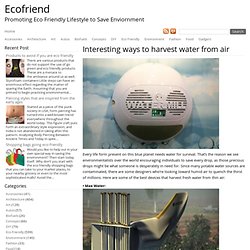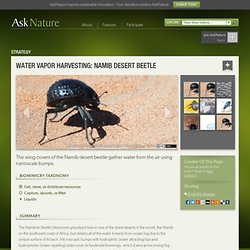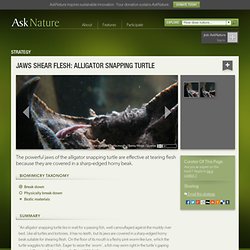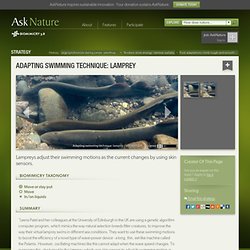

10 interesting ways to harvest water from air. Interesting ways to harvest water from air Every life form present on this blue planet needs water for survival.

That’s the reason we see environmentalists over the world encouraging individuals to save every drop, as those precious drops might be what someone is desperately in need for. Since many potable water sources are contaminated, there are some designers who’re looking toward humid air to quench the thirst of millions. Here are some of the best devices that harvest fresh water from thin air: • Max Water: An Australian inventor has developed a device that is capable of harvesting unlimited water from air.
. • Watermill: Developed by Element Four, the Watermill generates and then filters water so that what comes out of it is fit for consumption. Positive News, Green Things, Microcredit and The Green Children. Bill reduces drag: black skimmer. Beak design absorbs high-energy impacts: toco toucan. Ramphastos toco occupies the canopy layer of the tropical rainforest.

It avoids dense rainforests,preferring more open habitats, such as woodlands, river forests, plantations, and palm grooves. It is commonly observed near human dwellings and it is abundant throughout its range. Ramphastos toco is the largest member of its family, which comprises 37 species. It is 25 inches long. The appearance of R. toco is very colorful. Ramphastos toco is a very noisy member of the jungle society. Thin "shells" resist impact loading: sea urchins. Solar Water Still and Pump. Water vapor harvesting: Namib desert beetle. The Namib Desert is characterized by high temperatures, strong winds, and negligible rainfall, but it does experience nocturnal and early morning fogs that move in from the Atlantic Ocean.

The fog droplets are unusually small, about 1-40 microns in diameter (human hair is about 50 microns in diameter) so could easily be carried off by the hot desert wind. To capture these droplets before they're gone, the darkling beele faces into the wind and unabashedly sticks its rear end high in the air as if mooning all the beautiful creatures of the world, and starts to literally drink the fog as the droplets readily condense on its bumps and role down deliciously into its mouth. Observations suggest each beetle gains an average of about 12 percent of its body weight after fog-basking. Watch Video. Tendons store energy: bushbaby.
Galagonidae Galagonidae Learn more at Organism/taxonomy data provided by: Species 2000 & ITIS Catalogue of Life: 2008 Annual Checklist.

Tendons store energy: bushbaby. Jaws shear flesh: alligator snapping turtle. Macroclemys temminckii Macroclemys temminckii GRAY 1856 Learn more at Some organism data provided by: TIGR Reptile Database Organism/taxonomy data provided by: Species 2000 & ITIS Catalogue of Life: 2008 Annual Checklist Application Ideas: Cutting machinery that requires less energy input, demolition work that uses shearing equipment that mimics the turtle jaw.

Industrial Sector(s) interested in this strategy: Manufacturing, demolition. Vibro-Wind. Energy boost from vortices: bull trout. When fish swim, they use an undulating motion that expends a great deal of energy.

But some fish, such as trout, have adopted a different swimming motion that enables them to better conserve energy: using water vortices. In a liquid environment, vortices are often released from stationary objects and other living creatures, including other fish. Trout use these water vortices to their advantage. They do so by adjusting their bodies and using a slaloming movement to push off the vortices, maneuvering in between them.
The trout slalom by moving the muscles closest to their head away from the center of a vortex force while at the same time, moving the muscles nearest their tail toward the vortex. Check out these videos to see the trout's slalom movement in action. "Researchers are studying how fish use surrounding vortices to provide an energy boost. Anchor has flexibility: bull kelp. Efficient propulsion system: bluefin tuna.
Krila/lopatice. Foot adaptations climb rough and smooth surfaces: insects. Inflating for protection: porcupinefish. Rolling into a ball for protection: pill millipede. Glomerida Glomerida.

Feet good for climbing: squirrel. Beak provides streamlining: common kingfisher. If a kingfisher had a rounded beak, such as on the left, it would push water ahead of it, scaring or displacing the prey.

Instead, the wedge-shaped beak and head (right) enters the water without a splash, increasing the changes of a successful hunt. Artist: Emily Harrington. Copyright: All rights reserved. See gallery for details. "[W]e had another challenge that we pursued to the test run phase. "Then, one of our young engineers told me that when the train rushes into a tunnel, he felt as if the train had shrunk. "Yes, there is, the kingfisher. "So we conducted tests to measure pressure waves arising from shooting bullets of various shapes into a pipe and a thorough series of simulation tests of running the trains in tunnels, using a space research super-computer system. "This shape has enabled the new 500-series to reduce air pressure by 30% and electricity use by 15%, even though speeds have increased by 10% over the former series. Shapes cover curved surfaces efficiently: tortoise. Adapting swimming technique: lamprey.
Petromyzontidae Petromyzontidae.
